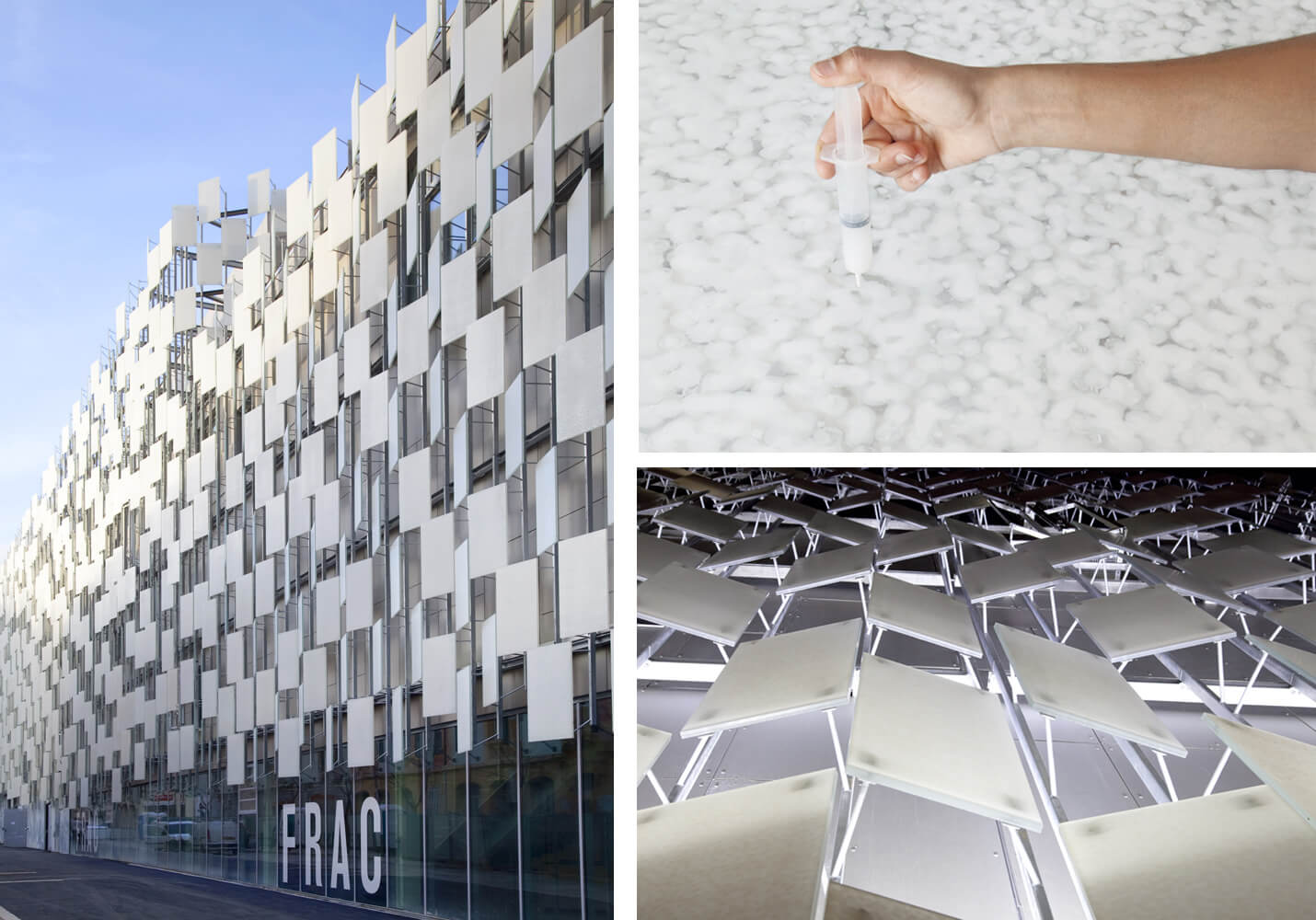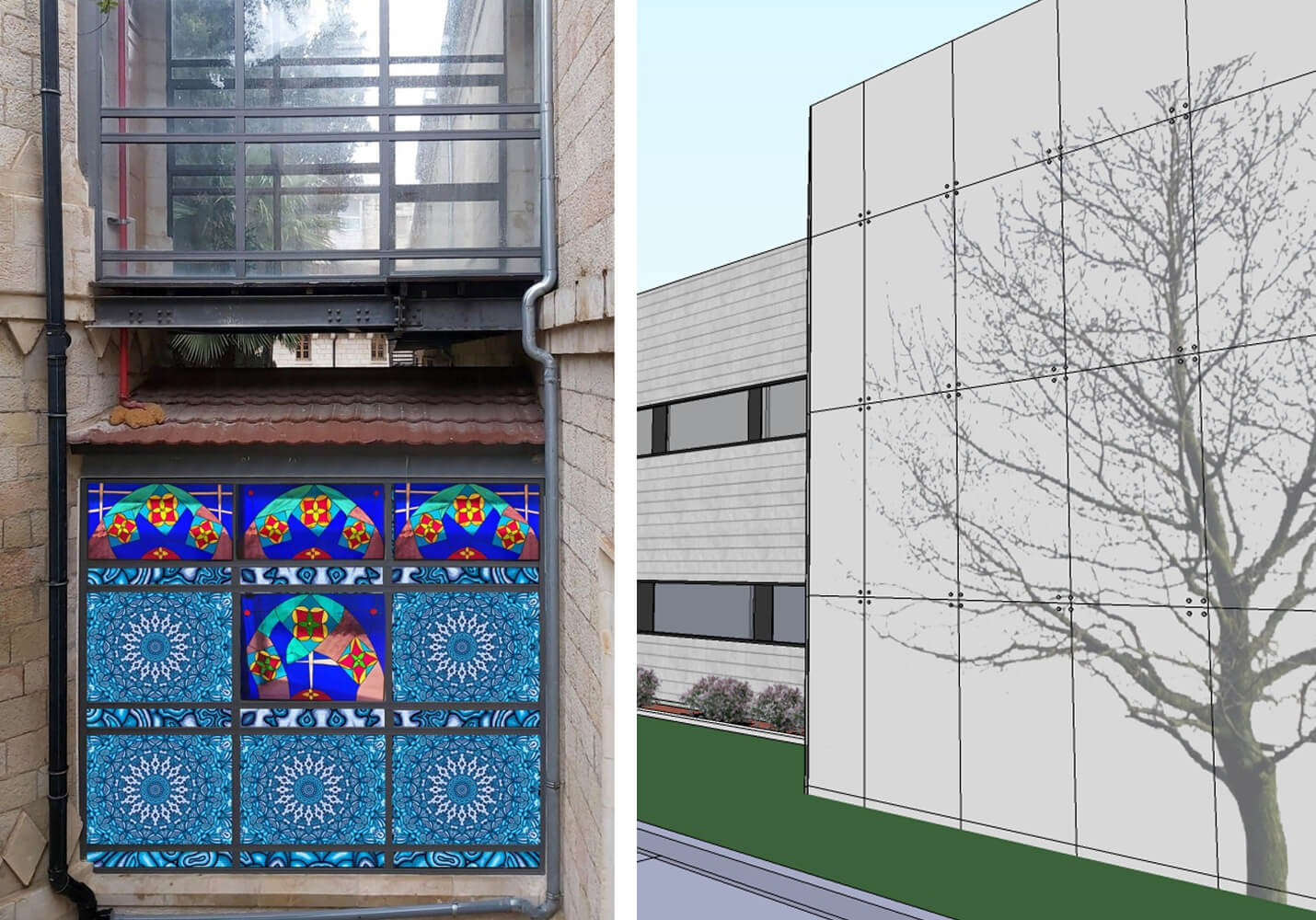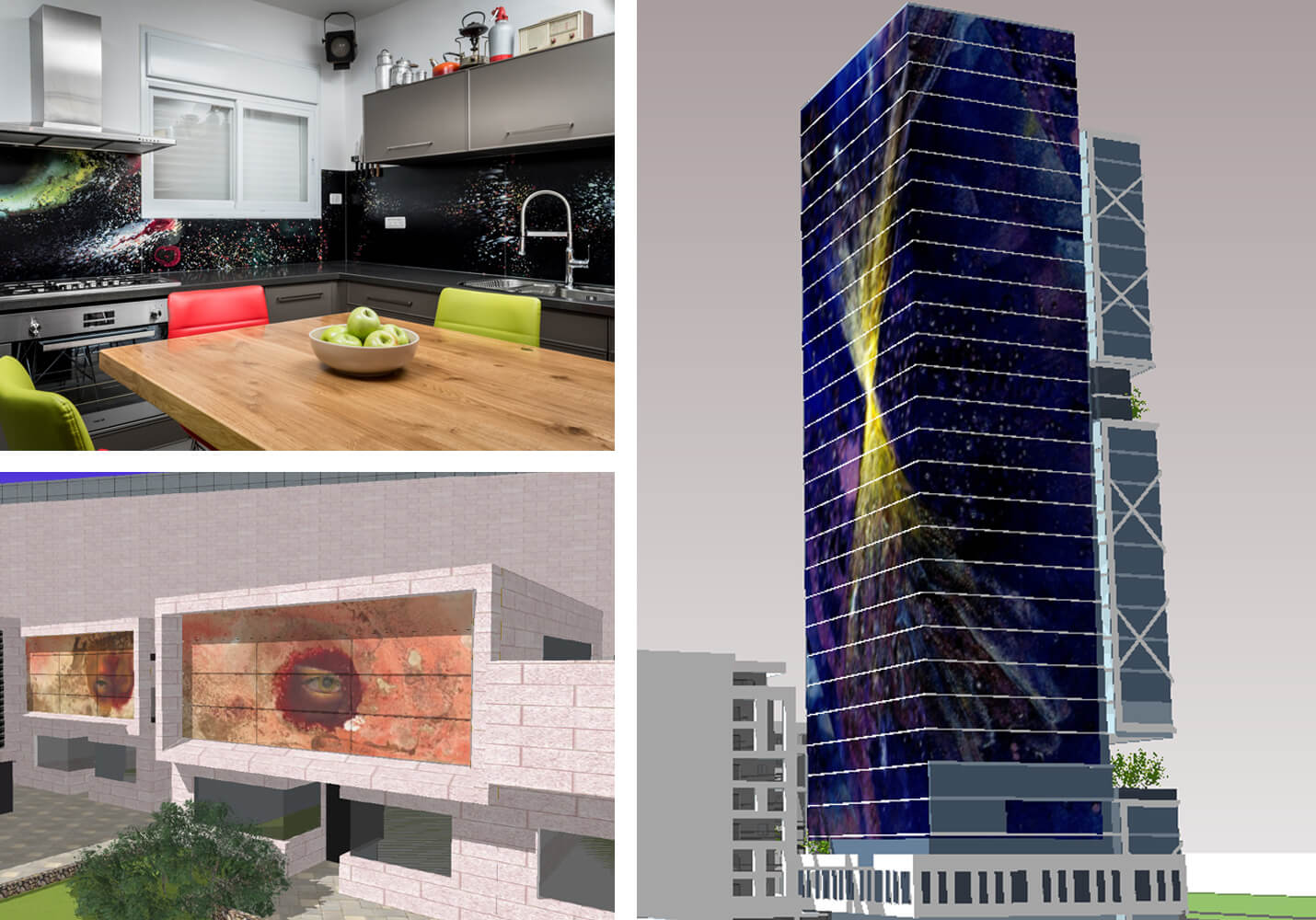Shifting into sophisticated High-Tech Design
By Eyal Porat Dip-Tech
Shifting into sophisticated High-Tech Design
By Eyal Porat Dip-Tech
Ferro, the largest glass coating company in the world, along with Dip-Tech, the pioneer of Digital Ceramic Printing, has contributed immensely to architects and engineers over the years, seeking the most functional coating solutions for architectural glass.
Today, we see a strong shift from large printed facades, to highly detailed interior printing, being the artists behind these graphics as the main source of creativity.
Ferro has provided artists with a vast toolbox for them to experience over the years, as we can see in this one project in Paris called The Frac. The artists worked along with the architects to create these heat-reducing textures applying s1de ONE® Ferro paste directly onto 1700 panels. A perfect combination of aesthetics & durability.

Architect Kengo Kuma. Glass Produced by Atelier Emmanuel Barrois.
Before today’s printing technologies, artists and designers had to spend days and nights bringing their creative artwork to life. This meant countless hours of sketching, testing, producing, and fixing, based on their clients´ demands. If there were any issues with the end result the artists would either start all over or have the client “settle” for whatever outcome they provided. Either way, the work became too tedious and too slow for the accelerated world we live in.
Digital Ceramic Printing eases up the whole process, without having to worry about the time cost implications of free-hand design.
Regardless of the highly appreciated effort and romanticism behind hand-crafted artwork, this kind of approach was becoming less effective when implementing art into architectural and urbanistic projects, having to comply with stressful deadlines and extensive regulations.
On a positive note, more and more artists were being called to participate in various private and public projects due to new building regulations, requiring architects to implement a certain percentage out of the total budget into art.
Today, architects and developers are not only interested in saving time but looking for new and creative methods to implement art into their projects, and through the most functional and durable way. This is where Digital Ceramic Printing comes in handy. Any design created by the artists could be printed with the highest precision directly onto glass panels, for either functional or decorative use and using specially developed Digital Ceramic Inks, transforming their artwork into permanent pieces.
Guardian Art Center, located in the area of the Lake Yang-cheng-hu, in Suzhou, China. Art designed by David Gerstein.
All this work is easily done through design tools that are provided by Dip-Tech for the designers, enabling them to get the best results out of their original ideas through innovative pattern generating programs, graphic libraries, and color simulations. Plus, thanks to cutting-edge Digital Ceramic Printers such as the brand new DX3, digital printing has become easier, faster, and more user-friendly than ever.
We interviewed 3 experienced artists who already transcended their line of work and mastered Digital Ceramic Printing as a solution to today´s demands:
Ran Green is a well-known glass artist from the Middle East, creating stained glass for more than 31 years. His specialties are hand-made Stained Glass for religious projects, such as Synagogues and Churches. He also worked on several public and private buildings, both in the middle east and around the world.
It was a lovely coincidence. I studied the product and fell in love with it. As an artist with over 33 years of experience, I realized the potential and wanted to expand my artistic services. This way I could reach out to much bigger projects in the public space.
The quality of printing and all the possibilities. From simple dots’ design to complex multi-layer graphics, and the ability to project my art on large facades. Combined with a light system, the façade becomes iconic during nighttime as well and is visible from distances. The ability to filter UV light and reduce heat is done very easily and can be calculated by anyone. Finally, I appreciate the constant support given to me by Dip-Tech’s team of support.
First, I’m old school, so I always start with hand drawing. But it is very easy to transfer the image to a digital format and from there to printed with amazing results.
To create a multi-layer image, double vision, and a print that could be appreciated day and night. This way my art becomes dynamic and full of essence. It is simply easier to create digital stained glass, especially on larger scales. And of course, financially it becomes much more accessible.
Starting 2020, a project for Hotel Sergei in Jerusalem, which went through a total renovation. I created a classic stained glass combining digital ceramic printing. I’m also working on a façade for a health center, which will begin construction soon.

Hotel in Jerusalem and project in Carmel. Art designed by Ran Green
To get in touch with Ran, email info@vitran.co.il
Ted Bar is a painter and writer, located in Israel. Ted developed a unique technique for painting and has shared his new artistic approach through various workshops around the world. He has recently completed a project a project in China, where his art was implemented into a building´s façade.
I started my digital printing projects with Ferrari cars in 2015, there are 2 Ferrari cars in Boca Ration FL. printed with my art, attached one's image. the next project was innovative kitchens with Tifa design studio, this time the printing was on the glass, then I collaborated with one of Dip-Tech dealers named Janor that had my first Ceramic glass printings of my art that eventually were installed on his ceiling's showroom. my current project is a collaboration with the architect firm V5 led by architect Benny Perry to have art printed on a 26-floor building on highway 431 in Israel
the main advantage in my opinion is the transparency and the ability to turn my art into a light object that gives the art image a different dimension. one of my main series is Deep Space inspired by the Hubble Telescope images, when a star image or a galaxy are printed on glass with the proper lighting the result inspiring.
I see a huge potential in having a totally different look to skyscrapers by having art printed on the building surface, most of the high buildings are copy-pastes, art and colors would add an innovative joyful look and can change the visibility of the whole area
it really amazes and inspires me to see the reactions, all this issue of art on buildings is in its childhood stage, we have a long way to go, but the beauty with children is that they are most creative, this creativity lasts till they join the school and are swallowed by the system, so, at this primordial stage we can experiment, dare and be most creative, I envision an office area as Down Town Manhattan with 10 skyscrapers printed with my stars and galaxies, I think it would totally change the skyline and would turn the gloomy Wall St. into a colorful playground
I am a great believer in the collaboration between art and architecture and art and design, Ceramic -printings add a new dimension to the art by enabling it to be printed on large scale surfaces, if we add to the aesthetic part a temperature and light control that can save energy it is a win-win situation to any modern building. architects and developers should have information about the Ceramic printing opportunity that should melange art, efficiency, and architecture. in the beginning, we will have to push our ideas but soon I am sure planners and developers would require the Ceramic Glass printing method
my art method is called FLY which stands for Free the Life within You, I wrote a book about this method - 'FLY - Have magic in your life that can be found on Amazon
there are 2 additional sites
for my art: www.tedbarrart.com

Private Kitchen backsplash, commercial building façade, and Arnona project in Jerusalem, designed by Ted Barr.
Finally, San Francisco based Stephen Galloway has featured his work in several exhibitions and galleries, including the Museum of Craft and Design and the Corden Potts Gallery. Stephen has done several collaborations with Dip-Tech providers around the world, from the US to China-
My most recent work created with Dip-Tech printing was a 3752 meter façade for a corporate headquarters in Silicon Valley, California. As an act of creative placemaking, we designed a stylized composition of a walnut tree to pay homage to the site’s agricultural past. At the same time, the materials, the glass printing, the engineering, and the graphic styling make a thoroughly contemporary artwork, fitting right in with the hub of innovation.
There was no question that Dip-Tech digital ceramic printing was the way to go. Public commissions and integrated art projects like this one generally demand a minimum of 25-year longevity. Given the exposure of this exterior façade, a printed interlayer was really out of the question. Fused glass and ceramic frit coloring have a long history of stability and beauty. However, the traditional techniques used with ceramic frit colors wouldn’t have worked for this project. Hand painting was out of the question because of the scale. Silkscreen application would have really limited the number of individual colors.
Digital ceramic printing brought speed, consistency, and a huge number of colors to the project. I use a lot of digital techniques in creating my art, so translation to the printing process is seamless. The track record that Dip-Tech printing is running up makes it easy for architects, developers, and city planners to appreciate.
In certain ways, having moved from the print world to the durable materials world, I have had to reimagine how to create and design. With each project, I am finding some new way to manipulate Dip-Tech printing. While I am skilled in making super-high-resolution photographs, it’s rarely called for in large-scale projects. Large, photographic raster images can be made with digital ceramic printing, but there are limitations when working with subtle color transitions. The workaround is to focus more on vectors and vector conversions. The fields of solid color and hard line that the technology affords are great qualities to work with.
Because of my past projects, I often get asked about architectural glass solutions for particular sites. For exterior locations, I’m not sure the durability of ceramic frit can be matched, so I strongly recommend it. As an artist, the more I work with the technology, the more I find I can do with it.
A commercial project using a vector logo or pattern and just a few colors could be created with a single or two-step sampling process. The complexity of my imagery requires an extended process, going back and forth between the Glass Processor and me to get everything just right. I have done projects with small, boutique glass studios and large industrial providers. I have been on-site with technicians, working hand in hand to discover the best way to process the artwork. I have also worked remotely with a manufacturer in China, shipping samples back and forth until we got it right. Even there, however, I traveled to Beijing to finalize the printing protocols and do quality control The exciting part about that job was seeing the production of these huge panels of laminated glass, all of them matching perfectly.
Absolutely! Digitally printed glass provides a cost-effective, beautiful option for public art and art integrated into the architecture. Given the growth in percent for art programs in the US and more interest in creating signature buildings, I can only imagine more opportunities moving forward. As always, the key for artists is collaborating with open-minded, skilled technicians who really understand the technology.
Find out more about Artist Stephen Galloway work at www.stephengalloway.com

Element: Grove. Private development in San Francisco, art designed by Stephen Galloway.
On a final note, high quality artistic printing requires high quality printers, this is where the new Dip-Tech DX-3 Digital Ceramic Printers stands out from the crowd. The smart autonomous technology provides the highest throughput and maximum versatility for glass processors to achieve the demanding artistic result. Combining Ferro’s 100 years of experience with ceramic inks, plus Dip-Tech’s innovative digital technologies you have yourself the best printing solution out there.
Want to know more about Dip-Tech & Ferro bird-safe solutions? Click here